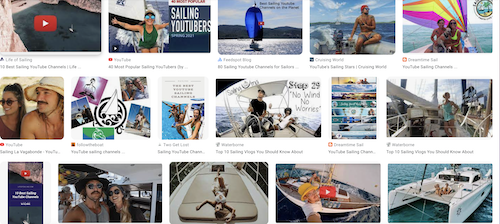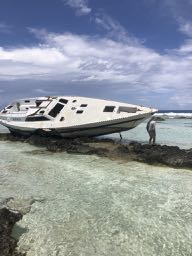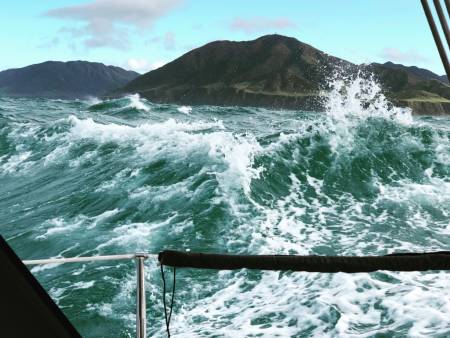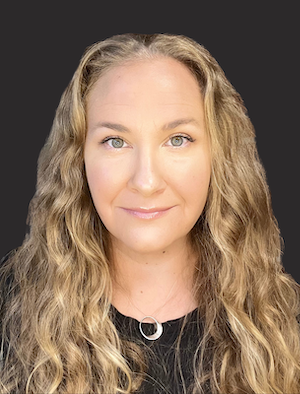INSIGHTS: YouTube versus Cruiser Reality
YouTube has become a staple in the sailing community – but is it having a negative effect on cruising? Fourth generation cruiser and live-aboard, Erika Lelievre, looks at the hype created by YouTube cruising channels versus the reality of a cruising life.
Published 2 years ago
Every community has their pendulum cycles. If you’ve ever gotten a chance to sit down with someone who can speak about personal cruising experiences from 10 or more years ago, it’s quite a different story than today. Their inspiration, their drive, their experience, and their sense of reality is polarizing. There are so many things that have changed in society and the digital age is a huge one.
YouTube Reality?
An extremely high percentage of pre-cruisers are getting their inspiration and “skills” from YouTube. Getting inspiration from YouTube is positive, propelling people to follow new dreams and creating an adventurous life for their family.
But are YouTube channels showing the true reality of the cruising life? Is it possible to experience the positive and negatives of this lifestyle through your screens? And, most importantly, is it creating a dangerous situation where people with zero actual experience are feeling as though they are skilled enough just by watching, that they are compelled to take their lack of experience straight to open oceans – that could care less about the experience a crew has.


My perspective is as a cruising family from 2010-2011 and as a live-aboard for 14 years – on a 44’ sloop, a 42’ trawler, and a 42’ catamaran. I’m the founder and administrator of Kids4Sail (K4S), a very active 7K member, worldwide Facebook group for cruising families. I started K4S when we set out sailing as a family in 2010, and it continues to be the #1 group for cruising families today. K4S was originally started as a way to find friends for my daughter 12 years ago as we lived the travelling life. The group was started on different platforms and finally landed on Facebook, as the social connections were easier to find and ultimately benefits families most. K4S has gone through cycles like everything else and being the admin puts me in a unique position to really get a true sense of the cruising family community as a whole.
Five Generations of Liveaboards
My experience as a sailing family started way back in my family. My daughter is the 5th generation as a liveaboard – following my great-grandfather, grandfather, father and myself. My husband had met and befriended a cruising family as a youngster and that’s what sparked his liveaboard life. Boats for the both of us were more than just recreational – they were homes.
As a couple we definitely wanted a boat kid with their unique nature of respect for Mother Nature, ability to adapt, learning lifelong skills, and to have that awesome boat-kid way of communicating with anyone, regardless of age. So we found our first boat, made a baby cabin, and brought home our daughter to our sailboat. Prior to setting off cruising, we sat down with long-time cruisers, we drove and drove to meet them in person, we took notes and listened intently, we were interested in the good parts but also had a keen ear for the more challenging parts.
We knew deep down that the lifestyle would be hard at first and we expected it to be.
Local Experience
My husband and I bought our first real liveaboard sailboat years prior to leaving the dock, to get experience locally – sailing in good weather and bad. It was hammered into our brains the importance of putting our hands on all of the boat’s systems, to be able to know them inside and out, to be able to fix them and maintain them ourselves. It was essential to learn about the weather and how to read the sky and water before setting off.


It was smart to test the relationship to be able live with each other for an extended period of time in a small space, to do a little local cruising with trips to laundromats with babies and foldable cart grocery shopping while walking miles. It didn’t mean our extended family wasn’t worried when we cast off the lines – they were worried what Mother Nature would hand us, the bad weather destined to happen. Not about us or our skills, mentally and physically, as a family and our boat.
Books and Relationships
Not once did I mention YouTube. Inspiration came from books and real relationships. The realities of life aboard and family dynamics came from real life interactions where we were seeking out the challenges, not just tales of beautiful sunsets and dolphins. We learned to actually sail. We learned to fix the boat’s systems with in-person classes and by fixing what was broken ourselves during those invaluable beginning years.
And we’re not alone.
This is the way 95% of the cruisers entered this lifestyle – with skills and experience. No, they aren’t necessarily fifth generation live-aboard sailors, but they bought their boat, they took a great amount of time to learn and gained necessary skills on their boat, and they cruised locally to get comfortable with their boat. Then they cast off their lines for further destinations.
The Tides have Turned
Now the tides have turned. These newer generations of cruisers get inspired (great!), buy the boat and leave to travel full time. They feel that they will get experience by just getting out there and doing “it” while traveling. There is truth to that, don’t get me wrong – the learning curve is sharp for even the skilled.
The most worrisome trend in all of this that I see: Many are lacking the basic skills to fully be able to learn safely and efficiently from that just-do-it “experience” they’re out to chase.


For example, a year or two back, my father passed a grounded sailboat and asked if they needed any help kedging off. Their response was that they just needed cell service to check YouTube to see how to do it. True story. Their complete lack of skill made their just-get-out-there experience useless and dangerous – as their boat was getting hit by wave after wave. Don’t think they are the only ones.
It’s Much More Difficult!
From my experience behind the scenes, new cruisers are finding life on the water much more difficult than they ever imagined. Their expectation of the cruising life is of an extended vacation. They know there will be storms and some sleepless nights.
But no matter how many YouTube channels you watch, it does not prepare you for those conditions in real life.
Watching from the screen removes the very real effects of the water, wind, exhaustion, and other environmental inputs. The screen does not adequately give you the feeling of 20 ft cresting waves or a 50 knot gust. It doesn’t let you truly feel how Mother Nature challenges you. Honestly, it doesn’t even come close. And just because you have $1M to buy a huge boat, it most definitely doesn’t make this “experience” any safer, but can have the opposite effect.
Listen and Learn
The spoken and written word plays on our imagination and perspective in a very different way than video does. When someone sits you down in-person to tell you how the crossing went with 20’ cresting seas and 50+ knots, you listen. You internalize it. You feel their energy. You innately interact with that experience. Your heart starts pumping and you lean forward and cock an ear to hear more. Questions start pouring out. What did they do? How did they sleep? What did they eat? Were they scared? How did the boat do? What did they learn from it? You can ask all of those questions and get responses back in real time with real emotion.


The intensity you just felt in those few minutes are more on-target than sitting on your couch and watching that same thing happen on camera during a YouTube marathon. For one, our brains are programmed to expect drama. The 20 ft seas on screen are completely different to the 20 ft seas under your own hull. They’re muted, they’re expected, they’re predictable, they’re just another show of 20 ft seas. The extreme scenarios better not be caught on camera, because all hands are needed on deck. If a person reaches for a camera rather than help on deck, question their priorities. If you’ve been in one of these scenarios and are reading along, you know there’s no way to catch the real essence of the experience through a lens. Nor should you try. Please don’t try.
The Social Climate of Cruisers
I’m also willing to bet that YouTube has had an effect on the social climate of cruisers now, as well. The cruising community as a whole hasn’t lost its signature willingness to help, openness to others’ lifestyles, sharing in tales and stories, and finding and keeping lifelong friends. But because of the accessibility of this dream, I have had increasingly prevalent reports of land-like behaviors of exclusion and cliques within the community – families gathering and purposely leaving out others. Not everybody has to get along, but a huge bonus to cruising years back was to escape those land-like behaviors and hierarchies.
Skills and social connections are not the only aspects that have changed, either. Leaving a “clean wake” has become more of a nuisance than an expectation – and I don’t mean picking up your garbage. Many people are not following country laws, not checking in and out legally, and are anchoring in areas that are protected or in such a manner that harms the environment. They are not trying to experience new cultures and ways of life that their traveling opportunities afford them, as their predecessors had. As a result, now the cruising life also includes research on which countries cruisers are not welcomed because of past behaviors – many of which are shown on YouTube channels. With all of the new cruisers watching “what not to do” with regularity, then feeling it’s not a big deal to not follow country laws and respect cultures comes as no shock.


- Maupitii Pass in Bora Bora, French Polynesia
Monetizing Cruising
Lastly, YouTube has monetized cruising. The channels make money off of your subscriptions, have sponsors that need advertising, and are therefore inherently biased. When you’re caught up in the daily drama of a YouTube channel, that fact is very much forgotten – purposely. When the seasoned cruisers sit to watch these popular channels, the behaviors on screen are often accompanied by snorts and eyerolling. If this aspect isn’t obvious to you, they’ve gotcha. If you hear of opposition to this fact, ask yourself if they are benefiting from this new burgeoning generation of cruisers.
YouTube most definitely opens the world to possibilities. It definitely sparks dreams. It has made the world a smaller place and has allowed more people, and thus playmates, to get on the water. It can be a way to work on building a few skills, like learning how to be a weatherman. And it can help with fixing very specific parts of systems when in a pinch.
Between a lack of skills through impatience, lack of true expectations, fading global and local social responsibilities, and monetization of dreams, YouTube is having some serious effects on the undercurrents of our community these past years. One day many of us will welcome when that pendulum starts swinging back to a balance. But until then, know it’s not the true reality of cruising you’re watching, that would be impossible.
Erika Lelievre
………………………………………………………………………………………………………………………………………
About the Author


Erika Lelievre is a fourth generation live-aboard cruiser following in the footsteps of her father, grandfather and great-grandfather. She was a live-aboard for 14 years and cruised with her family from 2010-11. She is the founder and administrator of Kids4Sail – a Facebook group for cruising families with 7k active members.
Erika is currently land-based on the US East Coast.
………………………………………………………………………………………………………………………………………
Other INSIGHTS can be found here.
Noonsite’s Cruising with Children Page.
………………………………………………………………………………………………………………………………………
The opinions expressed in this article are the author’s own and do not reflect the view of Noonsite.com or World Cruising.
………………………………………………………………………………………………………………………………………
Find out all news, reports, links and comments posted on Noonsite, plus cruising information from around the world, by subscribing to our FREE monthly newsletter. Go to https://noonsite.wccstaging.com/newsletter/.
Related to the following Cruising Resources: Cruising Information, Cruising Networks, Cruising with Children, Insights



Thanks, Sue, for the link to the CW article.
Erika, you make so many excellent points. We’ve also seen many changes in the cruising community with the rise of internet connectivity and YouTube.
It’s upsetting to see the accelerated monetization of cruising. It cheapens what is a beautiful lifestyle and seems to attempt to drag it into what the internet has become: a barrage of ads, unrealistic representations, and the surreptitious selling of product.
The cruising community is affected as more people spend time down below at anchor (watching YouTube videos of other people cruising???!) and interact less with their neighbors. The use of VHF – either monitoring for emergencies, calling for assistance, or requesting information from other boats in your proximity has plummeted in recent years.
One of the problems our community faces is that many cruisers use YouTube as the ‘goto’ place for information rather than asking experienced cruisers or referring to websites like Noonsite. It’s important to spread the word that there is more to cruising than watching videos, and that, though there is a lot of useful information in vlogs, many are unrealistic and simply vehicles to make money, stroke egos, and tout products.
Instead, let’s write articles, talk to fellow cruisers, express our opinions. You may get pushback from those who don’t want to hear that they’ve had a swig of the Kool-Aid, but our way of life need not be defined by vloggers – no matter how many followers they have — and the seas should not be abused for shallow profit.
Thanks for writing about this.
Cheers,
Bruce & Alene
s/v Migration
George Day, Editor of Cruising Compass [http://www.bwsailing.com/cc/], comments in Compass this month:
I think we need to look at ourselves, the cruising and blue water community, in the mirror; we should speak up when someone in our community announces plans to do something reckless. Sailing and cruising has always had mentors with experience who bring new sailors along. But perhaps in the age of Covid and YouTube, that mentoring process has broken down. Safe sailing and seamanlike passage making is no accident. It depends upon the three Ps: planning, preparation and practice. Every sailor who buys a cruising boat with ambitions to sail offshore should know this.
In light of the popularity of vlogging, blogging, ‘coaching’, etc., experienced long distance cruiser Bruce Balan of SV Migration’s recent article for Cruising World, is another good read on this topic: https://www.cruisingworld.com/people/making-a-case-to-disconnect/